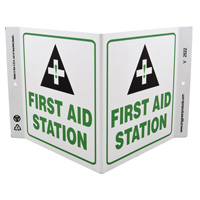



Find all of your laboratory and workplace safety supplies at Safety Emporium!
 Vertigo |
 Glossary Index |
 Viscosity.html |
| MSDS Topics |
Free Sites | FAQ's | Regulations | Glossary | Software | Suppliers |
| Books | Forum | Poll | Fun stuff | Quiz | Store | |
| Understand your MSDS with the MS-Demystifier | Search ALL our MSDS info | |||||
A vesicant is a drug or other agent that produces blisters. Vesicants are highly active corrosive materials even at extremely low concentration.
One of the most familiar examples of a vesicant is called mustard gas, which was used as a chemical warfare agent in World War I and the Iran-Iraq war. Mustard gas is a trivial name for 1,1'-thiobis(2-chloroethane), also known as bis(2-chloroethyl)sulfide or HD.


We have all kinds of safety wall signs at Safety Emporium.
Certain chemically related species are collectively referred to as mustards. These agents can be quite deadly as they have a high solubility in lipids (fatty tissues). Symptoms of exposure to mustard gas include conjunctivitis, blindness, cough, edema of the eyelids, and erythema or necrosis of the skin. When inhaled, this can severely and irreparably damage the respiratory tract. And to add extra insult to injury, mustard gas is also a carcinogen.
Vesicants have other uses besides chemical warfare; in these cases the vesicating properties are an undesirable/unwanted side effect or symptom. For example, some chemotherapy drugs are mild vesicants as are a variety of industrial useful chemical intermediates.
The Safety Data Sheet (SDS) should warn in Section 11 (toxicological information) if the material is a vesicant. Avoid the use of vesicants if at all possible. If a vesicant must be used, utilize the controls suggested in Section 8 (exposure controls/personal protection) of the SDS. Appropriate controls such as a fume hood can minimize exposure as can personal protective equipment (PPE) such as goggles, face masks, respirators, aprons, gloves etc. Do not rely on odor to warn you of possible exposure, vesicants can produce harmful effects at concentrations below the odor threshold.

Get your GHS-compliant labels and signs from Safety Emporium.
See also: lachrymator, poison, toxic.
Additional definitions from Google and OneLook.
Entry last updated: Sunday, February 6, 2022. This page is copyright 2000-2025 by ILPI. Unauthorized duplication or posting on other web sites is expressly prohibited. Send suggestions, comments, and new entry desires (include the URL if applicable) to us by email.
Disclaimer: The information contained herein is believed to be true and accurate, however ILPI makes no guarantees concerning the veracity of any statement. Use of any information on this page is at the reader's own risk. ILPI strongly encourages the reader to consult the appropriate local, state and federal agencies concerning the matters discussed herein.